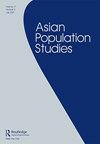南亚女性移民的新模式
IF 1.5
4区 社会学
Q2 DEMOGRAPHY
引用次数: 6
摘要
南亚国家根据性别表现出不同的内部移徙模式。在印度,女性长期以来一直主导着内部移民流动;1971年至2011年的人口普查显示,大约70%的终身移民是女性。相比之下,在孟加拉国,在二十世纪的最后三十年,男性的迁移多于女性(Afsar, 2000)。对一个具有优秀纵向数据的农村街道的详细研究也表明,男性比女性迁出更多(Alam & Khuda, 2011)。但在这两个国家,移民模式长期以来一直高度性别化:从农村地区到城市的迁移(特别是印度的邦际迁移)一直以男性为主,而地方性的迁移模式一直以女性为主。为什么女性在局部迁移中占优势?它源于次大陆的婚姻习俗,其特点是(特别是在印度北部)村外通婚,妇女在结婚后搬到丈夫的村庄。这些村庄通常离妇女的家乡不远,但有时更远。因此,婚姻(在南亚几乎是普遍的)要求大多数女性在达到结婚年龄后移民。虽然也有一些短距离的雄性迁徙,其中一些是季节性的,主要是为了寻找工作,但这远远超过了雌性的婚姻迁徙(Skeldon, 1985, p. 45)。由于人口普查所采用的移民记录规则,在许多国家,许多当地的人口流动没有被记录下来。这完全取决于要越过什么样的界限才能被视为移民。如果必须跨越地区边界,那么在地区内的移动显然不会被记录。在印度人口普查中,确定移民运动的最低单位是边界由行政规定的村庄和城镇。任何在村庄或城镇/城市边界以外的居住地的变化都有资格被归类为流动人口。考虑到村里的异族通婚模式,大多数妇女在结婚后迁往丈夫的居住地的情况都记录在迁移数据中。然而,孟加拉国的情况并非如此,在那里必须越过地区边界才能被登记为移民。(孟加拉国有64个区,平均人口约为250万)。在孟加拉国,村里的异族通婚虽然不是普遍实行,但很普遍,大多数婚后搬家的距离都在20公里以内(Rahaman, Akter, & Rahaman, 2010,图2);其中许多将在同一地区。因此,孟加拉国的人口普查无法捕捉到所有的婚姻变动。印度移民模式的性别差异是惊人的。根据2001年人口普查,最近70%的女性移徙者迁往农村地区,51%本文章由计算机程序翻译,如有差异,请以英文原文为准。
New patterns of female migration in South Asia
South Asian countries show different patterns of internal migration according to gender. In India, females have long dominated internal migration flows; censuses between 1971 and 2011 show that around 70 per cent of lifetime migrants were women. By contrast, in Bangladesh, in the last three decades of the twentieth century, more males than females moved (Afsar, 2000). A detailed study on one rural sub-district with excellent longitudinal data also shows more males than females moving out (Alam & Khuda, 2011). But in both countries, the patterns of migration have long been highly gendered: movement from rural areas to the cities (especially inter-state movement in the case of India) has been male-predominant, whereas localised patterns of movement have been femaledominated. Why this female predominance in localised migration? It results from marriage customs in the sub-continent, characterised (especially in north India) by village exogamy and women moving to their husband’s village on marriage. These villages were normally not very far from the woman’s home area, but sometimes further afield. Thus marriage (near-universal in South Asia) requires migration by most females after they reach marriageable age. While there is some short distance male migration as well, some of it seasonal, mainly for the purpose of seeking work, this is greatly exceeded by the marriage migration of females (Skeldon, 1985, p. 45). Because of the rules adopted in censuses for the recording of migration, in many countries much of the localised movement is not captured. It all depends on what boundaries have to be crossed in order to be considered as a migrant. If a district boundary has to be crossed, then moves within a district will obviously not be recorded. In the Indian census, the lowest units for determining migratory movements are the villages and towns whose boundaries are administratively defined. Any change of residence beyond the village or town/city boundary qualifies the person to be classified as a migrant. Given the pattern of village exogamy, most women’s moves to their husband’s place of residence on marriage are captured in the migration data. This is not the case in Bangladesh, however, where a district border must be crossed in order to be recorded as a migrant. (There are 64 districts in Bangladesh, with average populations of about two and a half million). Village exogamy is commonly though not universally practiced in Bangladesh, and most moves following marriage are less than 20 km (Rahaman, Akter, & Rahaman, 2010, Figure 2); many of these would be within the same district. The Bangladesh census would therefore not capture all marriage moves. The gender differences in migration patterns in India are striking. According to the 2001 Census, whereas 70 per cent of recent female migrants moved to rural areas, 51
求助全文
通过发布文献求助,成功后即可免费获取论文全文。
去求助
来源期刊

Asian Population Studies
DEMOGRAPHY-
CiteScore
3.30
自引率
14.30%
发文量
12
期刊介绍:
The first international population journal to focus exclusively on population issues in Asia, Asian Population Studies publishes original research on matters related to population in this large, complex and rapidly changing region, and welcomes substantive empirical analyses, theoretical works, applied research, and contributions to methodology.
 求助内容:
求助内容: 应助结果提醒方式:
应助结果提醒方式:


